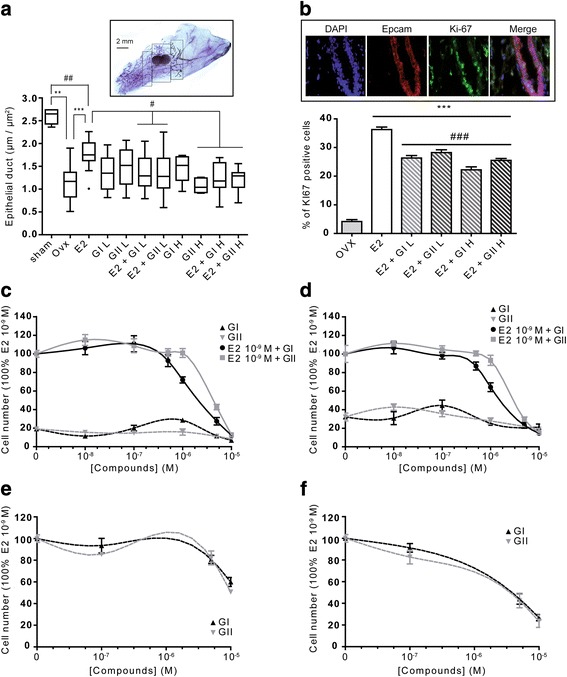Fig. 1.

Effects of glyceollin I and II on epithelial duct growth in mouse mammary glands and on ER-positive and ER-negative breast cell lines. Mammary glands were obtained from non-ovariectomized (non-ovx) or ovariectomized (ovx) mice treated with vehicle, 10 μg/kg E2, 50 mg/kg glyceollin I or glyceollin II (GI L or GII L, respectively), or 100 mg/kg glyceollin I or glyceollin II (GI H or GII H, respectively) either alone or in combination with E2 for 72 h (a). Epithelial duct length was assessed by delimiting an area around the lymphatic ganglion and measuring the length of this area using FIJI software (Cartridge). The results are represented in box-and-whisker plots, where the top and the bottom of the box correspond to the 75th and the 25th percentile, respectively. The horizontal bar in the box is the median, and the points outside the box correspond to extreme values. The results are expressed in μm/μm2 +/− SEM and were obtained from four independent experiments with at least 5 mice per group. *p-value <0.05 and ***p-value <0.001 with a Mann-Whitney test followed by Bonferroni correction for comparisons of ovx vs treated mice. #p-value <0.05, ##p-value <0.01 and ###p-value <0.001 with a Mann-Whitney test followed by Bonferroni correction for comparisons of E2 vs the other treatments. The anti-proliferative effect of glyceollin was assessed using Ki-67 and Epcam immunostaining of mammary gland tissue (b and cartridge). The immunostaining was performed on frozen slices of mammary glands around the lymphatic ganglion for ovx and E2-treated mice in combination with the two glyceollin concentrations. Then, the number of Ki-67-positive epithelial cells was determined with FIJI software. The results are expressed as the percentage of Ki-67-positive epithelial cells and represent the mean +/− SEM of three independent mice per treatment. ***p-value <0.001 with a Mann-Whitney test followed by Bonferroni correction for comparisons of ovx vs treated mice. ###p-value <0.001 with a Mann-Whitney test followed by Bonferroni correction for comparisons of E2 vs the other treatments. The effects of glyceollin on cell proliferation were also assessed in the ER-positive breast cell lines MCF-7 (c), T47D (d), and HC-11 (e) and the ER-negative breast cell line MCF10A (f). Cells were grown for 6 days with or without 10−9 M estradiol (E2) in the presence or absence of different concentrations of glyceollins. The numbers of cells measured in the presence of glyceollin I (black hatched line) or II (grey hatched line), either alone or in combination with E2 (full line), are expressed as percentages of E2-treated cells (c and d) or untreated control cells (e and f). The results are presented as the mean +/− SEM of four independent experiments
